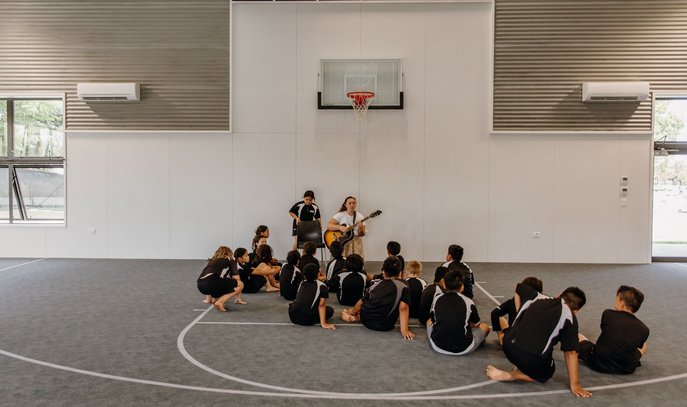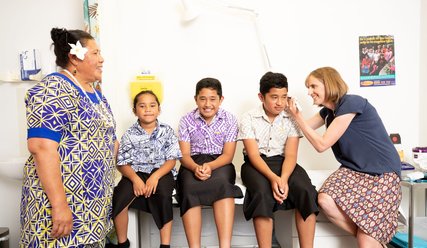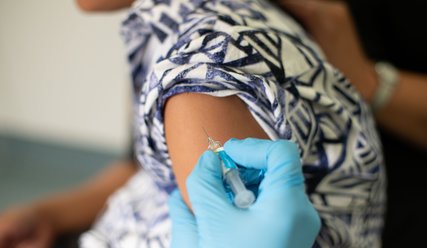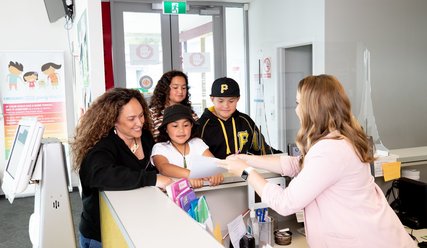What building a school can teach us about health equity
When a student at school turns up with a tub of ice-cream for breakfast because they, ‘couldn’t find a pie’ then you know that something’s wrong. It’s the kind of thing that could easily make national news headlines and have people wringing their hands with the horror of it all. But it’s also the kind of thing that you do when you’re a hungry kid who doesn’t know there’s other options.
For Matt O’Dowda, principal at Kimi Ora School in Flaxmere, Hastings, the kid with a tub of ice cream for breakfast was his student and living in a way that he’s set about changing. By building a new school, revising the curriculum, and making learning relatable to the experiences of his students, he’s creating an education model with Hauora Māori at its core. As he says, “nobody cares what reading level you’re on if you’re young and on dialysis for Type 2 diabetes.”
“It was only two or three generations ago that Māori were chiefs but until recently if I’d asked my students (half are Māori and half are Pasifika) what they thought it meant to be Māori or Pacific they’d have said, ‘oh it means being poor and stink.’” And why would you think any differently if you’d grown up at the end of Hastings where the streetlights get dimmer the closer you get to your house, or where the council doesn’t build great parks and playgrounds, or where the fun kind of programmes that are run at the community centre are 4.5 kilometres from your house and there’s no bus? There’s a pool nearby but it’s fully booked out for kids from wealthier suburbs to take private swimming lessons or practice canoe polo. Nobody locally has a canoe.

“People ask me for data about what we’re doing here to prove it’s working,” says Matt. “And I say to them, I’ve got 150 years of data to show me that everything we’ve been doing for Māori and Pasifika is rubbish and we need to do it differently.”
And doing it differently they are.
“My goal here is to have my students leave this school feeling proud to be Māori or Pasifika,””
Back to the ice cream. Four years ago, Matt asked the school community to stop bringing food and started providing it, firstly for a $1 a day koha and now as part of the government’s Food in School’s programme. Prime Minister Jacinda Ardern launched the programme after her visit to Kimi Ora school where she talked to Matt about the work they were doing.
The average income of the people in Flaxmere is $19,000 a year. Houses are rentals ($450-$500 a week) sleeping sometimes up to 15-16 people in a two-bedroom house. The year seven and eight students are more times than not the main cook for the family. And what do you cook when money’s tight and tummies are hungry, and food is expensive? White rice. Noodles. Sandwiches. Or a combination of the three together.
Carbohydrates are calorie dense foods and while they fill people up, they also, especially when eaten in abundance, add weight. And increased weight adds to the likelihood of Type 2 diabetes, a disease that is rife in this community.
A tsunami of Type 2 diabetes is quietly overwhelming our health system. There’s 220,000 New Zealanders living with Type 2 diabetes with an estimated 11 percent of the health budget going towards treating it each year. Māori are affected three times as often as Europeans, and Pacific people five times as often. In New Zealand, 54 percent of renal dialysis unit patients (people with advanced kidney disease) are there because of Type 2 diabetes.
Teaching food knowledge is a massive part of what Kimi Ora is doing – but it’s just one part of transformational change. The whole school is a new build and deliberately built to seem familiar, and therefore welcoming, to the community it serves. There’s a waharoa as whānau enter. All the school buildings are designed to mirror the pitch of marae buildings and in the large, concreted courtyard they’re adding a celestial compass next to the fale, which the local Tongan church uses twice a week for church services.
The classroom is open plan (everyone is here together) and has the kind of kitchen that would look at home in one of the country’s top design magazines. That’s so the kids can learn to cook and increase their food knowledge as part of the curriculum. Their fresh produce is now sourced from the school’s garden – that’s out the back between the big sandpit and the shaded area that overlooks the new bike track and short basketball court – perfect for three-on-three games.
“Much of our learning is done outdoors despite the Ministry of Education only funding the buildings at our school because outside isn’t classed as a learning environment,” says Matt.
‘Out and active’ as what Kimi Ora is about and while they’re there they’re learning. A native forest is being planted to teach the kids about flora and fauna. Traditional patterns are being incorporated into the forecourt, which will provide a starting point for art projects that have meaning and link back to whakapapa.
“I came out the back here recently and saw a group of 20-something Samoan guys hanging out on the basketball court. I’ve never seen them before so asked where they stayed (over the back fence was the answer). They’d started coming over to shoot hoops instead of being inside gaming, which they’d been doing until now,” says Matt.
That’s the point really – integrating activity, food knowledge, and concepts of mātauranga Māori into regular, healthy ways of living is the core kaupapa of the school. The level of body awareness and anatomy teaching at school has skyrocketed too and it’s having an impact in the community through tuakana/taina as kids go home and share their knowledge with whānau, who are making changes too, like cutting down on sugary drinks.
When the College’s Hawke’s Bay GPEP year 1 registrars visited the school as part of Te Ahunga in February, the school year was just back in session. “Some of our students put on 10 kilograms over the summer break,” says Matt “just because they no longer had access to the healthy options they get at school. It’s a long-term process of change for us.”
“It’s about staying alive,” says Matt. That may seem extreme, but in this community, you don’t often see old people because they’re dead. That’s especially true for Pasifika people who probably won’t get their Gold Card because they won’t live to see 65.
“I want our kids to get old,” says Matt. “So they can be healthier but also so they don’t need to see the doctor so often.”
His goal seems loftier than that though. By raising up this community he’s not just creating healthy long-living Māori and Pasifika people, he’s creating the next generation of doctors.


